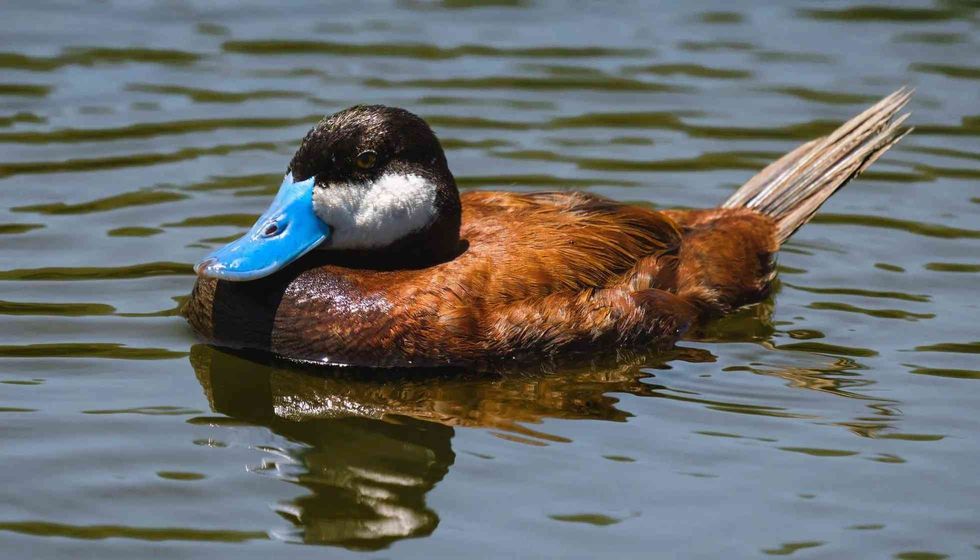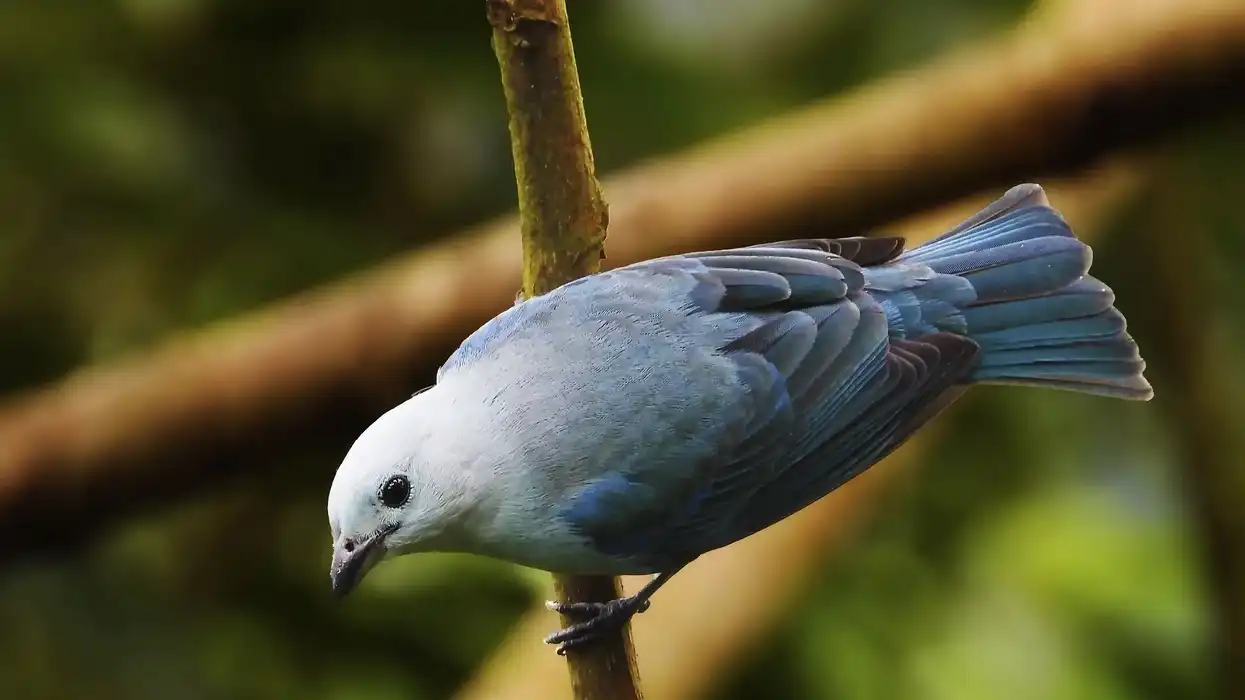The blue-billed duck is a type of stiff-tailed, diving duck native to Australia. These ducks are almost completely aquatic. Adults are about 14-18 in (35-45 cm) long and weigh about 28-30 oz (800-850 g). Mating males have a deep chestnut plumage.
They have darker heads and necks. Mating males also have a bright blue bill. This gives the species their name. Females have darker plumage and a brown bill. They have small bands of light brown adorning their feathers.
The blue-billed duck is not only a diving duck but also one of the only two species of stiff tail ducks native to Australia. The other stiff tail duck found in Australia is the musk duck. They are similar species with some differences.
These birds are omnivorous. This means they eat aquatic invertebrates, as well as, plants and fruits. They spend most of their lives in the water.
During their non-breeding season, they are seen in freshwater lakes and dams in large flocks. During the breeding season, these mating birds flock to densely vegetated, deep swamps of freshwater. They are a polygamous species.
If you want to read more interesting animal facts, please check out our forest falcon and saker falcon pages.
Blue-Billed Duck Interesting Facts
What type of animal is a blue-billed duck?
The blue-billed duck (Oxyura australis) is a type of duck indigenous to Australia. It is also one of the two species of stiff-tailed ducks found in Australia.
What class of animal does a blue-billed duck belong to?
The blue-billed duck (Oxyura australis) belongs to the order Anseriformes and the Aves class of the Animalia kingdom.
How many blue-billed ducks are there in the world?
The exact number of these birds in the world is unknown, but the blue-billed duck has a Not Threatened conservation status in the IUCN Red List. This means they have a stable population and there are enough of them in the world.
Where does a blue-billed duck live?
The blue-billed duck is indigenous to Australia. They are most often found in South East and South West Australia in the wetlands.
What is a blue-billed duck's habitat?
Blue-billed duck birds have an almost completely aquatic habitat. They are rarely found on land. They are found in the temperate regions of Australia.
Their habitat depends on their breeding season. In the non-breeding season, younger ducks usually flock in hundreds in open lakes and dams, usually far away from the shore.
This happens during autumn and winter. During the breeding season, adults prefer densely vegetated, deep, freshwater swamps. They are also known to be found in rivers and billabongs, which are saline water bodies, but it is very rare.
Who do blue-billed ducks live with?
The breeding cycle affects how the birds behave. They usually live and fly in large flocks during the winter while not breeding. During the breeding season, adults often live in pairs.
How long does a blue-billed duck live?
The exact lifespan of this species of birds is not yet known. However, it is estimated that blue-billed ducks have a lifespan of about 10 years in the wild. In captivity, however, they tend to live longer.
How do they reproduce?
The breeding seasons for these birds can vary, but it is usually from August to November. Males have a complex mating ritual.
They tend to breed in unfrequented freshwater swamps with dense vegetation. They make their nests over water, mostly in cumbungi beds like Typha and bullrush.
They use dead Typha leaves to make their nests. These ducks are polygamous in nature and only come together as a pair for short bouts of time.
They stay as a pair during mating and egg-laying. Females lay about four to six eggs in a single clutch, but the numbers of the eggs may vary from 3-13. Larger clutch sizes may mean that two females laid eggs in one nest.
They incubate the eggs for about 27 days. These ducks are partially migratory and they move from mating grounds to lakes and rivers in the non-breeding season.
The young only remain in the nest for a day before their mother leads them out and they become independent at a young age. They become almost the same size as their parents and within a year they acquire adult plumage.
What is their conservation status?
The conservation status of blue-billed duck birds is listed as Not Threatened in the International Union for Conservation of Nature Red List. This means that they have a safe population and are not Endangered. Their population trend is also stable and not declining, which is good news.
Blue-Billed Duck Fun Facts
What do blue-billed ducks look like?
The blue-billed duck is a type of stiff tail duck native to Australia. Breeding males of the species of birds have a deep chestnut plumage with darker necks and heads.
Their plumage returns to a darker gray at the end of the mating season. They also have a slate blue bill that becomes a brighter blue during the mating season. The blue bill of male ducks is what gives them their common name.
Females retain a darker plumage with light brown tips throughout their adult lives. They also have a brown bill. Females of the species look quite similar to the female musk duck but have a much darker plumage.
A musk duck is a similar species of stiff tail ducks native to Australia. Both males and females have darker tail feathers that are pointy and stiff.
They usually lay them flat on their bodies, but occasionally display them. That is why they are a type of stiff tail ducks.
The blue-billed duck and the musk duck are the only stiff tail duck species found in Australia. The adult blue-billed ducks are about 14-18 in (35-45 cm) long and weigh about 28-30 oz (800-850 g). Juveniles usually acquire adult size and plumage within a year of their births.

How cute are they?
These ducks are pretty cute, like the harlequin ducks. They have dark bodies with pointy tails. Even though it can be dangerous to get near them because they live in large flocks and can become quite defensive, they are very beautiful to look at. The males have a very beautiful blue bill that earned them their name.
How do they communicate?
Not much is known about the communication between these ducks, but they are a mostly silent species of ducks. They only utter rapid sounds and low quacks rarely and a lot of their more creative communication is seen while the male chases the female for breeding.
A series of physical displays, followed by a long chase is needed before the female finally agrees to mate. They are also very secretive during breeding time and often will submerge themselves into the water when they feel threatened instead of flying away.
How big is a blue-billed duck?
The average length of adult blue-billed ducks is about 14-18 in (35-45 cm). They are smaller than a crested duck.
How fast can a blue-billed duck fly?
The exact speed of the blue-billed duck is unknown. However, we know that they usually escape danger by flying away, especially during the non-breeding season. So we can assume that they are good fliers. They are also partially migratory in nature, this means they also have great wing strength.
How much does a blue-billed duck weigh?
The average weight of adult blue-billed ducks is about 28-30 oz (800-850 g).
What are the male and female names of the species?
Even though there are no specific male or female names for their species, like every other duck species, males are usually called drakes, while females are just referred to as ducks. But usually, they are known as male and female blue-billed ducks.
What would you call a baby blue-billed duck?
Like every other duck species, the young blue-billed duck is also called a duckling.
What do they eat?
Blue-billed ducks are omnivorous birds, meaning they eat both animals and plants. Their plant diet consists of seeds, buds, stems, leaves, and fruits. Their animal diet mostly consists of invertebrates like dragonflies, water beetle larvae, and caddies flies.
The blue-billed duck feeds on the surface of the water, as well as, by diving inside the water. They also find food by stifling the mud underwater with their bills. This almost completely aquatic duck is a species of diving duck.
Are they dangerous?
They are not dangerous birds. They are almost completely aquatic and cannot walk well on land. They are not known to attack. Instead, they fly away or hide in the water when they feel threatened.
Would they make a good pet?
It is probably not a good idea to keep these birds as pets. They are flock animals that need to live in groups and can feel alone if they do not have others surrounding them. They are also partially migratory and keeping them as pets would mean taking their freedom away.
Did you know...
Blue-billed ducks seldom come out of the water. They have a very uncomfortable gait on land, almost like penguins, and prefer to spend their lives in the water.
They are a protected species so it is illegal to hunt them.
What sound does a blue-billed duck make?
These birds are mostly silent. Males sometimes make low-pitched rattling noises and females have a soft quack, but they seldom use them.
Naming the blue-billed duck
Breeding males of the species have a light, bright blue bill. This is why the species is called blue-billed ducks.
Here at Kidadl, we have carefully created lots of interesting family-friendly animal facts for everyone to discover! For more relatable content, check out these forest owlet facts and white gyrfalcon facts pages.
You can even occupy yourself at home by coloring in one of our free printable Blue-billed duck coloring pages.










